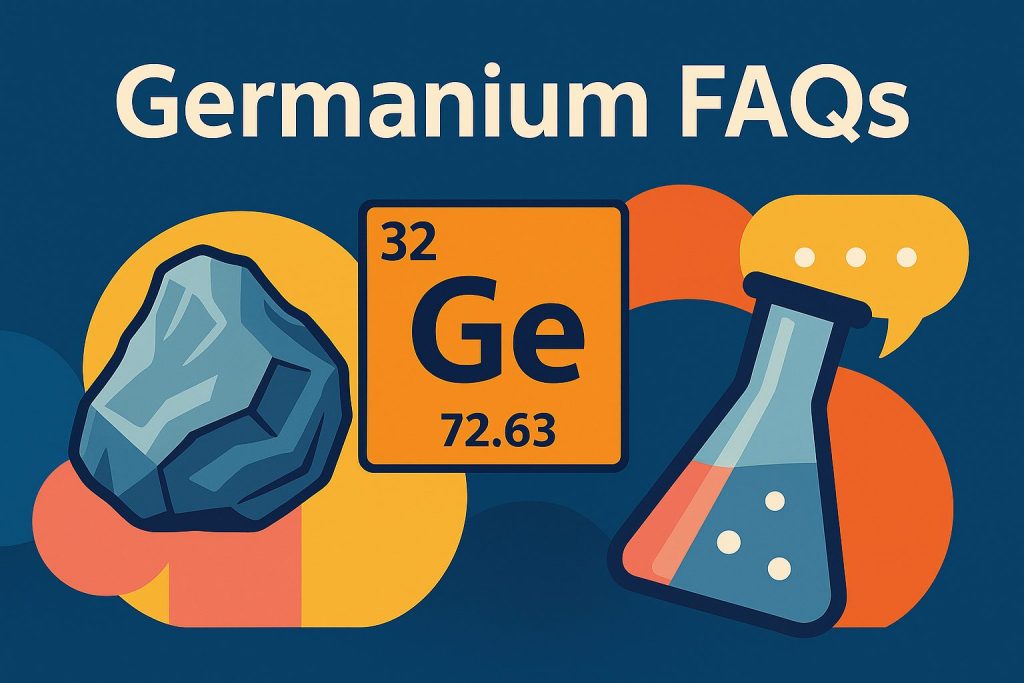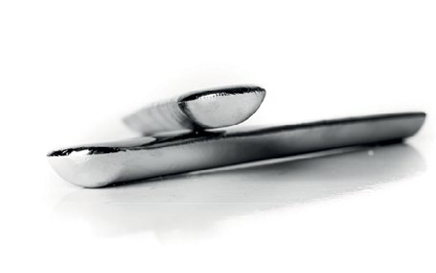The Fiber-Optic Phantom Powering the Internet and Infrared

Curious about Germanium? You’re in the right place. In this FAQ, we explore the many aspects of germanium—from its origins and characteristics to its practical uses and why it’s gaining attention as an investment.
Whether you’re intrigued by its semiconductor role, geopolitical relevance, or storage questions, we’ve answered the most common (and uncommon) queries right here.
🔬 Properties & Physical Behavior
Germanium is mainly used in fiber optics, infrared optics, PET production, night vision devices, and solar cells due to its excellent semiconductor properties.
Germanium is a hard, brittle, silver-gray metal with a shiny metallic luster.
Germanium is a metalloid, meaning it has properties of both metals and non-metals—making it ideal for semiconducting applications.
Germanium has the symbol “Ge” and atomic number 32. It sits in group 14, period 4, between silicon and tin.
Germanium has 32 protons.
Germanium and silicon have just the right number of electrons to conduct electricity under controlled conditions, making them ideal for semiconductors. Their atomic structure allows for precise control of electrical conductivity, essential in electronics and photovoltaics.
📖 History & Discovery
Germanium was discovered in 1886 by Clemens Winkler.
Germanium was discovered by Winkler while analysing the mineral argyrodite, in an attempt to isolate unknown elements predicted by Mendeleev’s periodic table.
Germanium was named after Germany, the home country of its discoverer, Clemens Winkler, who isolated it in 1886.
🌍 Origin & Production
Germanium occurs in zinc ores (like sphalerite), coal, copper ores, and germanite. It’s typically obtained as a by-product of zinc or lead refining.
Germanium is found globally but is primarily produced in China (who dominate global production), followed by Russia, Canada, and Belgium.
Germanium is quite rare in high concentrations, with most deposits requiring secondary extraction from other metals. It’s mainly obtained as a by-product of zinc smelting and coal combustion residue.
Germanium isn’t mined directly. It’s typically recovered as a by-product during the refining of zinc, copper, and lead ores — especially from sphalerite. China is by far the largest producer, responsible for around 70–80% of global output. Other sources include Russia, Canada, and Belgium, but as with many strategic metals, China dominates both production and exports. That makes germanium not just rare, but geopolitically sensitive.
Precise reserve data is limited, but the U.S. relies heavily on imports to meet its germanium needs, most of which come from China. Domestic production is minimal and mostly tied to zinc mining operations. Given its essential role in defense and tech, germanium is officially listed as a critical mineral by the U.S. government.
⚙️ Uses & Applications
Germanium is used in fiber optics, infrared lenses, PET production, night vision goggles, and semiconductors. It also plays a growing role in solar cells and military tech. If you’re using high-speed internet, odds are you’ve got germanium to thank.
Germanium is vital to modern communications, defense systems, and renewable energy. It enables the precision and clarity needed for infrared imaging and high-speed data transfer, making it a cornerstone of both national security and next-gen tech.
Germanium is rare, tricky to extract, and mostly produced as a by-product of zinc and copper mining. Add to that export bans from China (the top supplier), and you’ve got the perfect recipe for high germanium prices. Demand is rising fast, but supply isn’t keeping pace.
🧪 Safety & Handling
Elemental germanium is considered low-toxicity, but organic germanium compounds can be toxic in high doses.
Germanium cannot kill you in its metallic form. However, long-term exposure to certain organogermanium compounds can be harmful.
Yes, germanium earrings are generally safe, though people with metal sensitivities should check for purity and alloying components.h precision.
💼 Buying, Investing & Storage
While trace amounts of germanium might be available through science supply stores or hobbyist channels, these aren’t suitable for industry use or investment. If you’re looking to acquire high-purity, industrial-grade germanium, it’s essential to go through a specialised dealer. At Strategic Metals Invest, we offer germanium in certified, industry & investment-grade form, direct from top-tier producers. Each purchase includes full documentation and access to a resale network of industrial buyers.
Investing in germanium means physically owning it—either as an individual asset or within a diversified basket of strategic metals. Through Strategic Metals Invest, private investors can purchase high-grade germanium, receive an ISO-9001-certified Certificate of Ownership, and opt for secure, tax-free storage. With growing demand in fiber optics, defense, and clean tech (and ongoing export restrictions), germanium offers strong long-term potential.
Germanium is stable in solid form, but to preserve its purity and value, proper storage is key. For investors, we recommend housing your holdings in METLOCK’s high-security vault in Frankfurt. This facility offers banking-grade protection (security class 10 CD EX), full insurance, and climate-stable conditions. Storing your germanium professionally also ensures optimal resale conditions; your metals remain in original packaging, fully verifiable and ready for liquidation.
Whether you’re exploring germanium for academic interest or are serious about diversifying your portfolio, we hope this FAQ has been enlightening. Germanium isn’t just a hidden gem in the semiconductor world, it’s also becoming a strategic asset in the investment landscape. Contact us for more information.


